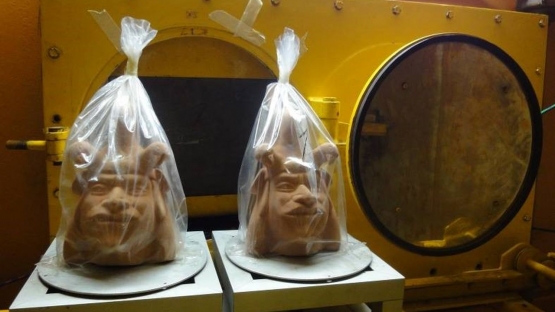Large Sample Neutron Activation Analysis (LSNAA), a non-destructive analytical technique, is comparable to the more established Neutron Activation Analysis (NAA) and can be used for the analysis of larger objects more accurately. This is the conclusion of the four-year coordinated research project (CRP) “Application of Large Sample Neutron Activation Analysis Techniques for Inhomogeneous Bulk Archaeological Samples and Large Objects”, and is summarized in the publication “Advances in Neutron Activation Analysis of Large Objects with Emphasis on Archaeological Examples - Results of a Coordinated Research Project, IAEA-TECDOC-1839 (2018)”. This publication features LSNAA methodologies and case studies developed during the CRP.
The aim of the CRP was to harmonize procedures of LSNAA and to encourage the application of this lesser known method in various areas of research, such as precious samples, art objects, archaeological specimens or food packets, as well as market-oriented applications in industrial waste, foodstuffs for export and potable water. The CRP examined the accuracy and sensitivity of the technique, which was only available at a restricted number of research reactors.
Experts from fifteen countries joined the CRP, including both laboratories with experience in LSNAA and newcomers to this technology. In the framework of the CRP, several new facilities were built, new approaches were developed, and experts demonstrated for the first time that accurate results can be obtained with LSNAA. The latter has been underpinned by a unique interlaboratory proficiency testing exercise: replicas of an intact clay pottery art piece were distributed amongst the participants, who each analysed them in their laboratories. The degree of agreement among the participants was high, reflecting the benefits of the LSNAA technique and the relative simplicity of its implementation.
“As part of this CRP, we established an international network that will contribute to the future use of LSNAA and many scientific publications and innovative methodologies. The IAEA will help countries to take full advantage of this technique,” said Danas Ridikas, Head of the Physics Section at the IAEA.
Determining the composition of an object or material is essential in many fields of science, including environmental studies, geology, advanced technology, food, nutrition and human health. In archaeology, the exact composition of an artefact, in particular of elements with minute concentrations, can be used to discover where the artefact came from or where it was produced: for instance, pottery made in different locations use different raw clay with different compositions.



